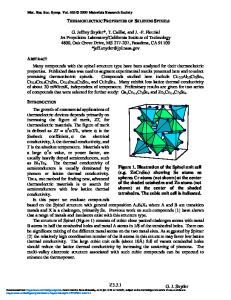Thermoelectric properties of superlattice materials with variably spaced layers
- PDF / 551,717 Bytes
- 8 Pages / 584.957 x 782.986 pts Page_size
- 39 Downloads / 810 Views
D.G. Walkera) Department of Mechanical Engineering, Vanderbilt University, Nashville, Tennessee 37212 (Received 15 December 2010; accepted 31 March 2011)
Variably spaced semiconductor superlattices (VSSLs) exhibited superior electron mobility and rectification because of electronic level alignment. We investigated the thermoelectric properties of VSSL structures using a self-consistent nonequilibrium Green’s function quantum model to capture the ballistic electron transport and anatomistic nonequilibrium Green’s function model to capture the phonon transport. A figure of merit was calculated as a function of temperature for two VSSL strain silicon–germanium materials and a non-VSSL material. Calculation of the figure of merit (ZT) versus temperature for a VSSL demonstrated a 17 times increase in power factor at the expense of a 4 times increase in thermal conductivity at room temperature compared to a comparable uniform superlattice. Calculation determined a ZT of 0.20 for a VSSL compared to a ZT of 0.04 for non-VSSL material at 400 K. VSSLs proved to be a candidate material to further increased ZT near room temperature for superlattice materials.
I. INTRODUCTION
We hypothesize that manipulated transport properties can be obtained from variably spaced superlattice (VSSL) structures through band engineering of superlattice materials that leads to enhancement of thermoelectric properties. This presumption is based on electrical studies of VSSL structures by other researchers1–3and our own investigation into the thermoelectric performance of regular superlattice structures.4,5 This research will demonstrate how variably spaced semiconductor superlattice materials not only outperform equally spaced superlattices but also exhibit anisotropic filtering behavior resulting in directionality of thermoelectric properties. This study is unique because (i) a directional Seebeck coefficient along a single crystalline axis has never been investigated or even suggested, and (ii) VSSLs have not been investigated extensively for thermoelectric applications. There are two distinct advantages to the electrical and thermal transport properties that arise from controlling the relative film thicknesses within the superlattice structure. The first advantage of increased electrical conductivity is illustrated in Fig. 1 and is a result of electronic confinement of the low lying energy levels of the conduction band within the well region. The second advantage is the reduced thermal conductivity, which is a result of the increased a)
Address all correspondence to this author. e-mail: [email protected] DOI: 10.1557/jmr.2011.194 J. Mater. Res., Vol. 26, No. 15, Aug 14, 2011
http://journals.cambridge.org
Downloaded: 25 Mar 2015
thermal boundary scattering that arises from the varying layer thicknesses of the well regions and the increased number of interfaces. The device geometry of VSSL structures are set by obtaining a favorable electrical structure and assuming the thermal properties will follow. Therefore, no optimization on the str
Data Loading...











